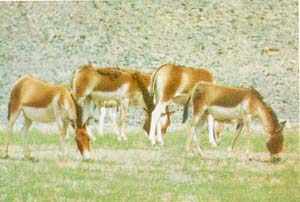
The Kiang or Tibetan wild ass, Equus Kiang Moorcroft, is the largest of all African and Asiatic wild asses. Basic colouration is reddish in summer to dark brown in winter with almost white underparts. Kiangs are considered to be closer to horses than to asses. Morphological similarities with horses are short ears, large tail tuft and broad hooves. Like all wild asses, they have a short upright mane and a dark stripe along the back extending from nape to tail.
The range of Kiang is very wide, extending from Tibet, Tsinghai and Szechuan regions in China to trans-Himalayan Indian regions of east Ladakh in Jammu and Kashmir (extending possibly into adjacent Spiti area of Himachal Pradesh), and north Sikkim. On the basis of colour and size, three distinct geographical subspecies of Kiang are recognised. These are: a small polyodon in south Tibet and north Sikkim, larger Kiang in east Ladakh and west Tibet and even larger Holdereri in east Tibet and Szechuan. Within Ladakh, the subspecies Kiang is restricted to the Changthang area,an upland plateau known for its pristine beauty and unique wildlife.
Physiographically, the Changthang is a southwest extension of the Tibetan plateau. General topography is rugged and comprises of vast marshy and sandy plains on more or less flat tablelands surrounded by barren mountains. Elevation varies from 4,000 m to 7,000 m above mean sea level. The area is drained by tributaries of the Indus river and bestowed with some very large brackish water lakes, namely, Pangong Tso, Tso Morari, Tso Kar, etc.
The climate is extremely dry and harsh with temperatures ranging between –400 C and 250 C, annual rainfall varying from 60 mm to 70 mm. The entire area remains under snow during the winter. The vegetation comprises alpine arid pastures, dominated by low thorny scrub (Loricera spinoide, Hippophae rhamnoides), Tibetan furze (Caragana sp.) and a variety of grasses (Festuca sp., Carer sp., etc).

Changthang was greatly disturbed in 1962 because of extensive military activity, affecting its ecology and wildlife. The entire area, covering about 4,000 km2 was notified in 1987 as a wildlife sanctuary for the protection of its unique flora and fauna. Strategically placed along China border, the Changthang Wildlife Sancutary remained out of bounds to tourists. Since 1994, tourists and others have been allowed to visit Pangong Tso and Tso Morari lakes in the area. Kiangs face serious threats to their survival due to disturbance (military activity and tourist influx), loss of habitat and livestock pressure.
The present status of Kiang is endangered. It is included in the ‘Red Data Book on Indian Animals’ brought out by the Zoological Survey of India, and protected under Schedule I of the Indian Wildlife (Protection) Act 1972 and Appendix II of CITES. A population of over 2,000 Kiangs in Ladakh has been estimated in the Red Data Book. The main concentration of the species is in a comparatively undisturbed area along Tibet border.
The High Altitude Zoology Field Station of the Zoological Survey of India at Solan surveyed the area in August 1995 to assess the status and distribution of Kiang in the Changthang Wildlife Sanctuary. The study area was 490 km2, located at about 220 km southeast of Leh and covered the following sectors: Nyoma-Hanle, Loma-Chishul through Tsaka La, Chishul-Lol Yogma, and Chishul-Mane along Pangong Tso.
In Ladakh, Kiangs inhabit open sandy tablelands near Tibet border at elevations between about 3950 and 4850 metres above mean sea level. They live in herds and feed upon sparsely growing sturdy grasses of Festuca sp. A herd comprises of adult males and females along with their foals. The size of a herd varies from 2 to 19 individuals or at times it may be as big as 45 or more (up to 84 individuals in a herd have been observed during a preliminary survey in September, 1994). Some solitary adult males are occasionally encountered.
Direct population counts indicate the highest density of 1.27 Kiangs/km2 in an undisturbed Dungti-Tsaka La sector of the sanctuary. The population is low in the disturbed sectors of Nyoma-Loma and Loma-Hanle. Partially disturbed Tsaka La-Chishul and Chishul-Lol Yogma areas have moderate populations. A population of approximately 188 Kiangs is estimated to exist in the sanctuary. These estimates are based on a density of 0.47 Kiangs/km2 for the entire sanctuary area of about 4,000 km2 and may vary considering their migration to and fro between Ladakh and adjoining Tibetan areas.
JM, Julka, JRB Alfred*,
HS Mehta and R Paliwal
High Altitude Zoology Field Station, Zoological Survey of India,
Solan, Himachal Pradesh
* Zoological Survey of India, 'M' Block, New Alipore, Calcutta-700 053